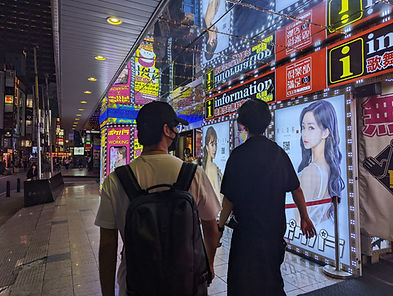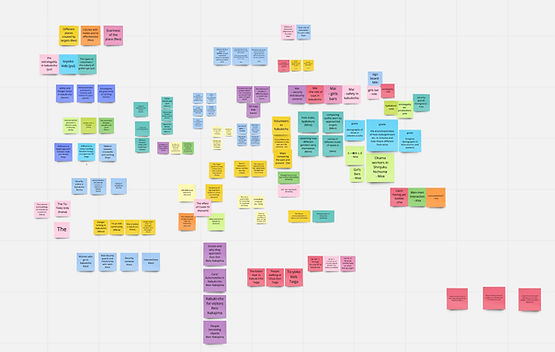
.png)
.png)
By shota
Introduction
Though each individual page provides an in-depth analysis of Kabuki-cho’s many facets, synthesizing the data collected through ethnographic fieldwork and bringing the projects together into a coherent webpage is no easy task. Focusing on seven unique themes, the web pages were constructed by students of Anthropology Practicum - Tokyo Urbanism course, taught by Professor David Slater at Sophia University. Under the guidance of Professor Slater the class explored various aspects of Kabuki-cho by conducting on-site fieldwork and reading theories that contribute to the understanding of the data we found. Throughout the entirety of the course, students used Notion, a free collaborative productivity software to coordinate deadlines, check assignments, take field notes, and make website pages. The field note data gathered by students were ultimately compiled into a notion database, where students organized observations in an online collaborative platform.
Background Readings,
and Finding a Focus
In order to make use of the field note data we collected effectively, students in the Anthropology Practicum course were assigned readings by sociologists such as Georg Simmel, David A. Karp, and anthropologist James Spradley among others. The materials provided theories to make sense of what we see, and guided students to conduct meaningful ethnographic research through our data.

Participant Observation, Spradley 1980, p. 27
One of the most important readings covered in the course was Participant Observation by James Spradley. Participant Observation provided a detailed guide as to the processes in which we should conduct ethnography, and it presented the theories and methodology needed to investigate meanings in our complex societies. Moreover, the reading provided a framework for students to find their focus of research by identifying the social situation.
The reading by Spradley moreover introduced students to the practice of organizing data collected into cultural and analyzed domains to create a “cultural inventory”. The students took a cultural inventory of their data to see the whole cultural scene of the places studied, and look for gaps in their observations. The reading, therefore, allowed students to gain a general understanding of practicing fieldwork and writing up an ethnography.
Taking Field Notes using Notion
Over the span of eight weeks, students of the course explored Kabuki-cho on a weekly basis. In correspondence to a set of guidelines and safety rules made by students prior to their research, fieldwork was conducted with safety in mind. Field notes were typed onto Notion at the site, or uploaded afterwards by examining photos and video taken from the field site. The use of Notion allowed students to upload and share their field notes into the class database in real time, allowing for easy access to everyone’s observations.

Students taking Fieldnotes on Hanamichi Avenue
Utilizing a Class-wide Fieldnote Database using Notion

Screen Capture of the fieldnote database, with the use of tags to categorize themes, location, type of place, theory, etc.
"It was convenient how fieldnotes are easy to access and you can use them easily as a source of data."
- Qiqi (Junior)
The innumerable amount of fieldnotes taken during the eight weeks of fieldwork needed a place to be filed and sorted. Therefore, a class-wide database was developed on the collaborative Notion platform to have all of the field notes in one central location. Students are able to edit on their phones and read notes written by others. Notion, being a project management tool with built-in spreadsheet tools, made categorizing and creating tags easy. When utilizing the database for their final ethnographic project, for example, students sifted through the database by filtering themes that were relevant to their project.
Miro: Using an Online Collaboration Tool to Brainstorm
Another program that was extensively used in the early brainstorming stages and during the process of creating cultural inventories of data, was Miro. The program allowed students to visualize final project ideas that others have written, and form larger themes based n the ideas presented on the board. Some groups utilized Miro to form the organizational structure of their research, by creating mind-maps that visualize the key domains and terms.
Mind-Mapping was useful as we tried to figure out best way to approach the complexity of the city as well as when began to think about how to represent it in this website.
Screen Capture of the Miro
brainstorming board.

Website Building using Notion

Screen Capture of the Scholarly
Literature database
For the final project, students formed groups based on 7 key themes of research they found interesting during the fieldwork process. The topics explored were: Signboards, Golden Gai, Shinjuku Ni-Chome, Security, Toyoko Kids, Scouts, and Anomalies of Kabuki-cho. Each group developed their ethnographic work by making use of the class-wide fieldwork database on Notion and reading literature on their respective themes. A separate database for scholarly articles was used to share relevant literature with classmates in the process of creating their website pages. The platform included many features. However, some have stated in a survey that it was a bit cumbersome to use, as formatting was based on note-taking word processors.
"There are many functions and features, especially when making your own page, that were difficult unless you were familiar with using Notion in the past."
- Moe (Senior)